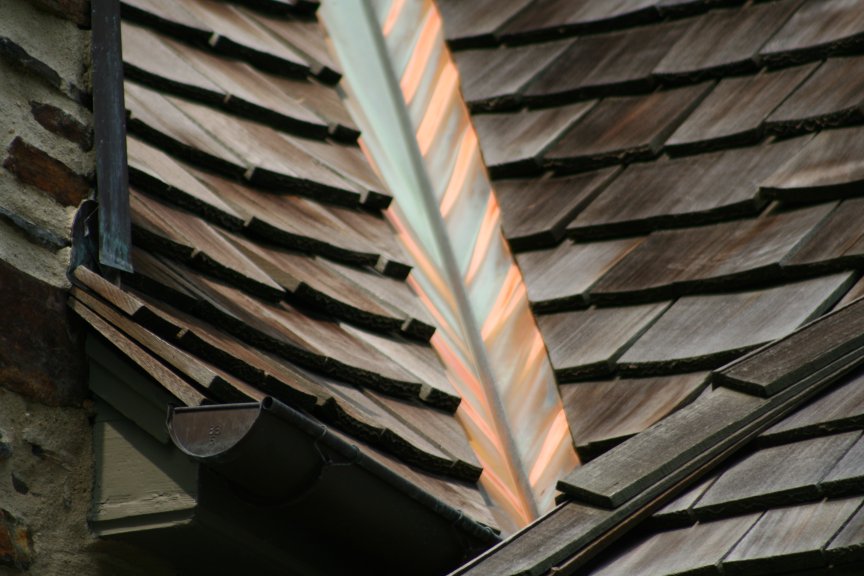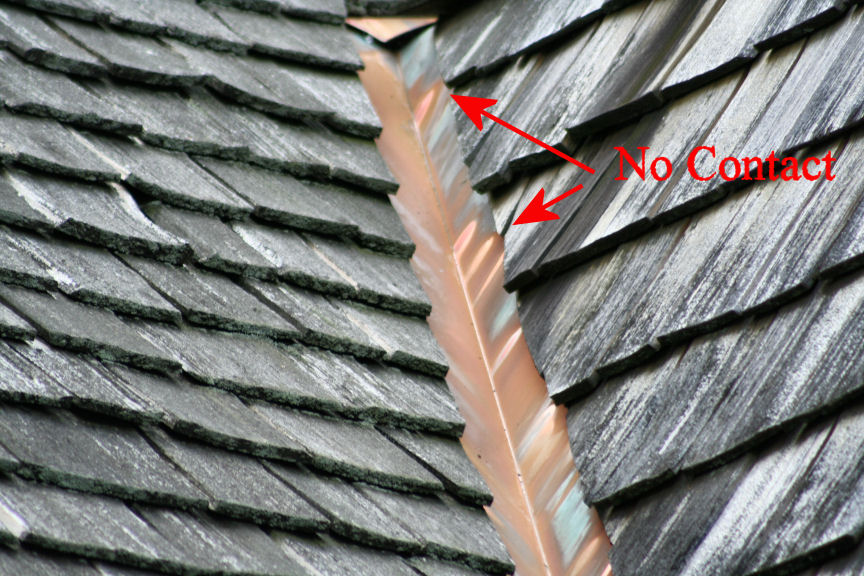Similar
to the fundamental
ignorance that exists in the roofing trades when dissimilar
metals are mixed, this fact of Cedar eroding Copper has
also been lost not only to the tradesmen, but to the “experts”
to whom the current crop of roofers look for direction.
“Although the acidity of rain in the eastern
part of the United States is high (low pH), rain by itself
isn't acidic enough to harm Copper.”
It
is mentioned on the "www.cedarburaeu.org" website
that “Copper can be used as a flashing in areas that
are not accustomed to acid rain.” It is also described
in several other writings found on the web that sulfur dioxide, the primary component
of "acid rain," deteriorates buildings and especially
Copper.
Certainly the folks over at the Cedar Bureau do recognize the problem of Copper degradation under a Cedar wash. On their question and answers section, an inquisitive visitor asked:
Can I use fire retardant treated cedar shakes or shingles as siding above a copper roof? Answer:
Certi-Guard® products will not affect the copper; the treatment seals any tannic acid into the shakes or shingles.
The old-time craftsmen knew from experience that the
sulfur dioxide from chimneys on coal burners within homes
emitted caustic exhaust that tended to corrode Copper flashings.
This fact contributed more to the use of Terne Coated Steel
flashings on old Slate roofs than the added expense of the
Copper metal, but the expense of the Copper is often given
for the reason of the steel flashings’ use. A careful
search for information regarding these facts will often yield
only a modernist viewpoint that the cost was the primary factor
in the use of Terne Flashings over Copper in these old roofing
applications.
Similarly, one can also find information regarding Copper
degradation from "acid rain," but for deterioration
from the surrounding materials on a given project, rarely
can one glean anything from contemporary articles on the subject
of architectural Copper degradation.
"...this writing is to inform the many
ill-informed in this industry that the run-off from Cedar
will degrade Copper flashings."
Long
before anyone heard the term "acid rain," it was
well known that the naturally occurring acids from Cedar would
degrade Copper flashings. It was also known that the soot
generated from a coal-fired furnace would eat away at Copper
flashings. A true student of old-time craftsmen and their
methods can only be in awe of the respect they had for the
realities that the "so-called" experts of today
can only derive from the scientific community and long-distance
theory. The science of yesterday's craftsmen consisted of
a pragmatic view and from lasting statements in their predecessor’s
workmanship. They knew how different materials functioned
and a certain harmony for relationships between given materials
was respected in the field. In today's market, however, tradesmen
are hard to find and the workers that do visit the trades
are often transients and most look to the "experts"
for advice and true experts are few and far between.
For
all intents and purposes, this writing is to inform the many
ill-informed in this industry that the run-off from Cedar
will degrade Copper flashings. Acid rain, or not, the acid
contained within the Cedar Shingles rots Copper! It has been
known for ages that Copper should not be used on Cedar Roofs!
Having experience in the field of roofing, our craftsmen have
learned from the tradesmen of yesterday. The roofers of yesteryear
did not use Copper on Cedar Roofs!
There
seems to be an argument from some within the industry regarding
the use of Copper on Cedar Roofs. It is apparent from the
modern applications where Copper is improperly used as a flashing
on Cedar Roofing that a certain type of erosion occurs that
is unique to the metal on Cedar Roofs flashed with Copper.
Acid rain plays no role in the increased degradation of Copper
flashing on Cedar roofs as compared to slate roofs. Cedar
Roofing degrades Copper. The blue-green protective patina
developed on the surface of Copper flashings balances and
protects the metal from sulfur dioxide degradation. This patina forms
on Copper installed onto Cedar Roofs, but the metal is quickly
robbed of its protective patina where the Cedar bleeds acid
onto the metal. Witnessing this, it is apparent that the amount
of run-off and not just the contact with, or "trapping"
of water between the materials, is the leading contributing
factor.
“Copper
located below Cedar Shingles especially is vulnerable, probably
because of acid extractives in the wood.”
The "Copper.org" website answers the question as
to the compatibility of Cedar Roofing and Copper. The suggestion
that the Copper and the "leading edge" of the Cedar
should be isolated tells of the reaction between the two materials.
Copper and Cedar should not be mixed so that the Copper accepts
run-off from the Cedar. This is the fundamental truth that
has been known for centuries. It has only been of late, in
this past half century, where we have lost the career tradesmen
that used to pass down the knowledge of their predecessors,
where we rely more upon opinions based upon theory than from
solid experience.
As
stated by Donald Baerman, an expert in this field and one
who has gone to great lengths to find the truth, “Copper
located below Cedar Shingles especially is vulnerable, probably
because of acid extractives in the wood.” Mr. Baerman
also states, “Although the acidity of rain in the eastern
part of the United States is high (low pH), rain by itself
isn't acidic enough to harm Copper.” We say thank you
to Donald Baerman, who has taken the time to investigate the
subject in great detail.
Just
do not mix Copper and Cedar and you will not have to worry
about any problems down the road.
As
for Cedar Sidings and Roofing, we will be writing about the
New Growth Wood issues and the truth about Cedar and life
cycles of exterior wood claddings.
A must read: Environmental affects on copper roofing. |



